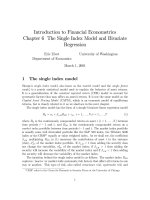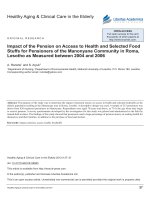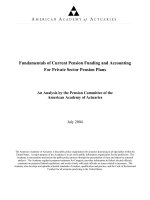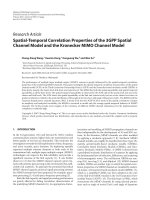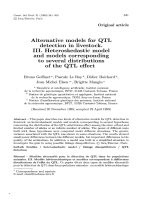The overlapping generations model and the pension
Bạn đang xem bản rút gọn của tài liệu. Xem và tải ngay bản đầy đủ của tài liệu tại đây (1.57 MB, 17 trang )
Contents
The Overlapping Generations Model and the Pension System
Contents
1.
Introduction
3
2.
The overlapping generations model
4
3.
The steady state
7
4.
Is the steady state Pareto-optimal?
8
5.
Fully funded versus pay-as-you-go pension systems
10
6.
Shifting from a pay as-you-go to a fully
13
funded system
7.
Conclusion
16
References
17
www.sylvania.com
We do not reinvent
the wheel we reinvent
light.
Fascinating lighting offers an ininite spectrum of
possibilities: Innovative technologies and new
markets provide both opportunities and challenges.
An environment in which your expertise is in high
demand. Enjoy the supportive working atmosphere
within our global group and beneit from international
career paths. Implement sustainable ideas in close
cooperation with other specialists and contribute to
inluencing our future. Come and join us in reinventing
light every day.
Light is OSRAM
2
Download free eBooks at bookboon.com
Click on the ad to read more
The Overlapping Generations Model and the Pension System
1. Introduction
This note presents the simplest overlapping generations model. The model is due
to Diamond (1965), who built on earlier work by Samuelson (1958).
Overlapping generations models capture the fact that individuals do not live
forever, but die at some point and thus have finite life-cycles. Overlapping generations models are especially useful for analysing the macro-economic effects of
different pension systems.
The next section sets up the model. Section 3 solves for the steady state. Section
4 explains why the steady state is not necessarily Pareto-efficient. The model is
then used in section 5 to analyse fully funded and pay-as-you-go pension systems.
Section 6 shows why a shift from a pay-as-you-go to a fully funded system is never
a Pareto-improvement. Section 7 concludes.
3
Download free eBooks at bookboon.com
Introduction
The overlapping generations model
The Overlapping Generations Model and the Pension System
2. The overlapping generations model
The households Individuals live for two periods. In the beginning of every
period, a new generation is born, and at the end of every period, the oldest
generation dies. The number of individuals born in period t is Lt . Population
grows at rate n such that Lt+1 = Lt (1 + n).
The utility of an individual born in period t is:
Ut = ln c1,t +
1
ln c2,t+1
1+ρ
with ρ > 0
(1)
360°
thinking
.
Discover the truth at www.deloitte.ca/careers
4
Download free eBooks at bookboon.com
© Deloitte & Touche LLP and affiliated entities.
Click on the ad to read more
The overlapping generations model
The Overlapping Generations Model and the Pension System
c1,t and c2,t+1 are respectively her consumption in period t (when she is in the
first period of life, and thus young) and her consumption in period t + 1 (when
she is in the second period of life, and thus old). ρ is the subjective discount rate.
In the first period of life, each individual supplies one unit of labor, earns labor
income, consumes part of it, and saves the rest to finance her second-period retirement consumption. In the second period of life, the individual is retired, does not
earn any labor income anymore, and consumes her savings. Her intertemporal
budget constraint is therefore given by:
c1,t +
1
c2,t+1 = wt
1 + rt+1
(2)
where wt is the real wage in period t and rt+1 is the real rate of return on savings
in period t + 1.
The individual chooses c1,t and c2,t+1 such that her utility (1) is maximized
subject to her budget constraint (2). This leads to the following Euler equation:
c2,t+1 =
1 + rt+1
c1,t
1+ρ
(3)
Substituting in the budget constraint (2) leads then to her consumption levels in
the two periods of her life:
c1,t =
c2,t+1 =
1+ρ
wt
2+ρ
1 + rt+1
wt
2+ρ
(4)
(5)
Now that we have found how much a young person consumes in period t, we can
also compute her saving rate s when she is young:1
s =
=
wt − c1,t
wt
1
2+ρ
(6)
The firms Firms use a Cobb-Douglas production technology:
Yt = Ktα (At Lt )1−α
with 0 < α < 1
(7)
where Y is aggregate output, K is the aggregate capital stock and L is employment (which is equal to the number of young individuals). A is the technology
5
Download free eBooks at bookboon.com
The Overlapping Generations Model and the Pension System
The overlapping generations model
parameter and grows at the rate of technological progress g. Labor becomes
therefore ever more effective. For simplicity, we assume that there is no depreciation of the capital stock.
Firms take factor prices as given, and hire labor and capital to maximize their
net present value. This leads to the following first-order-conditions:
Yt
Lt
Yt
α
Kt
(1 − α)
= wt
(8)
= rt
(9)
... such that their value in the beginning of period t is given by:
Vt = Kt (1 + rt )
(10)
Every period, the goods market clears, which means that aggregate investment
must be equal to aggregate saving. Given that the capital stock does not depreciate, aggregate investment is simply equal to the change in the capital stock.
Aggregate saving is the amount saved by the young minus the amount dissaved
by the old. Saving by the young in period t is equal to swt Lt . Dissaving by the
old in period t is their consumption minus their income. Their consumption is
equal to their financial wealth, which is equal to the value of the firms. Their income is the capital income on the shares of the firms. From equation (10) follows
then that dissaving by the old is equal to Kt (1 + rt ) − Kt rt = Kt . Equilibrium
in the goods markets implies then that
Kt+1 − Kt = swt Lt − Kt
(11)
Taking into account equation (8) leads then to:
Kt+1 = s(1 − α)Yt
(12)
It is now useful to divide both sides of equations (7) and (12) by At Lt , and to
rewrite them in terms of effective labor units:
yt = ktα
kt+1 (1 + g)(1 + n) = s(1 − α)yt
(13)
(14)
where yt = Yt /(At Lt ) and kt = Kt /(At Lt ). Combining both equations leads then
to the law of motion of k:2
kt+1 =
s(1 − α)ktα
(1 + g)(1 + n)
6
Download free eBooks at bookboon.com
(15)
The steady state
The Overlapping Generations Model and the Pension System
3. The steady state
Steady state occurs when k remains constant over time. Or, given the law of
motion (15), when
k∗ =
s(1 − α)k∗α
(1 + g)(1 + n)
(16)
where the superscript ∗ denotes that the variable is evaluated in the steady state.
We therefore find that the steady state value of k is given by:
k
∗
1
1−α
=
s(1 − α)
(1 + g)(1 + n)
=
1−α
(2 + ρ)(1 + g)(1 + n)
1
1−α
(17)
It is then straightforward to derive the steady state values of the other endogenous
variables in the model.
7
Download free eBooks at bookboon.com

